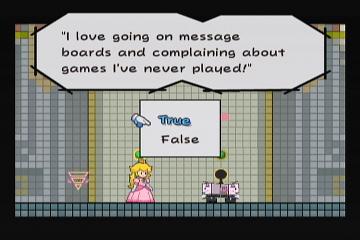

The Paper Mario series for N64 and GCN, an off-shoot of Mario's original RPG outing on the SNES, saw Mario venture out into an RPG world of a completely different sort. While in the SNES game everything had been full and detailed 3D, the new Paper Mario games saw him "flatten out," as he became paper thin, and the world around him took on a paper atmosphere of its own. Movement was still in 3D, he could move around areas at his will for the most part, but, everything had a particularly paper feeling to it. That new style, while something very different, was still the covering for a fairly straightforward RPG. Not that there was anything wrong with that of course, as if one enjoys RPGs they were all great games. That, however, might not have been one's style, and so, despite the interesting look, they might not have been games that caught one's interest.
With the recently released New Super Mario Bros. for the DS, Mario showed that he still had plenty of plain, ordinary 2D platforming left in him, the kind that had made itself so popular on the NES and SNES, but which had largely been lost in the transition to 3D. This new game showed that, indeed, people were still plenty interested in having Mario running along, jumping on Goombas, and all sorts of things reminiscent of what he had been doing since his younger days. Still, this outing, while new and refreshing, was on a handheld system. Handhelds, unlike consoles which had moved into 3D a while previous, had long been a stronghold for more traditional 2D gameplay like this. So, while it was certainly something new and welcome, it wasn't so much unexpected given the recent offerings on the format.
These two aspects, however, combined to form something completely unexpected. Super Paper Mario for the Wii is a beautiful blending of the best aspects of all of those games, together on a new system which, while still having plenty of 3D power and many great games in that format, gives a brilliant example of how the power of a new system can be used to enhance tried and true gameplay that has stood the test of time. This isn't to say, on the other hand, that this doesn't have plenty of new stuff that makes unique use of the new and interesting system it finds itself on. Still, what Super Paper Mario shows - at least in itself even if it might not bring forward a host of others - is that there's still plenty of nifty things that can be done, working around the solid core of that basic 2D platformer.
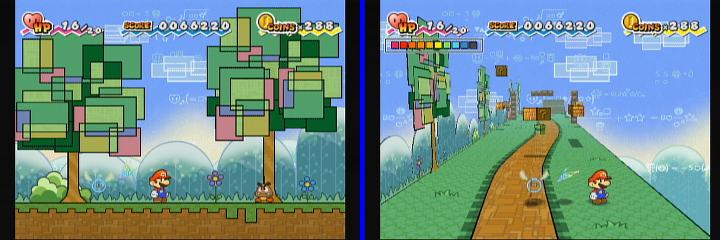
Super Paper Mario opens up with Mario and Luigi in their house, discussing amongst themselves how nothing much of interest has been happening lately, and that perhaps they should go visit the princess just to spend some time chatting as opposed to the usual saving her from captivity that they usually find themselves doing. No sooner had they headed out the door, however, than trouble lands itself squarely in their laps. The princess has, once again, been kidnapped, and, as usual, it's up to Mario to save her. This time, however, it's not Bowser who is doing the kidnapping; in fact, Bowser is just as upset about it as you are, although for different reasons, in that he wants to be doing the kidnapping himself. Now the princess finds herself captured by an evil Count from another realm, planning to use her in a fiendish plot to destroy the worlds and suck things into the void of dimensions. That's just the basic beginning part of the story, but, suffice it to say that there's much more going on here than the typical "Princess being locked away somewhere" that Mario is used to. From that starting point, Mario will find himself off on quite a different journey, with many new and unexpected things along the way.
Although the name Super Paper Mario would seem to indicate strong ties to the previous Paper Mario games, the actual play really has more in common with New Super Mario Bros. in that, again, the basis of play is that of a 2D platformer. While the game is for the Wii, where one of the main features is the new controller with all of the motion and such like that, when playing this game, the majority of the time will be with the controller held sideways in both hands, using the control pad with the left hand and the 1 and 2 buttons as if they were the A and B buttons on an NES controller. The big A button next to the control pad will come into play as well, but, much of the controlling aspect of the game feels very similar to as if it were an NES game. Of course, there's nothing wrong with that, it worked great there and it still works great here. The motion part of the controller can be used for a particular feature during gameplay however, where the controller can be turned toward the television to cause a spotlight to shine on the screen. Using this, the spotlight can be moved over different things of interest and get additional information on them. Of course, this isn't really anything that couldn't be done by just using a control pad to move a spotlight onto something, but, it does work easier being able to just flip the control pad and do it like that, and it does make a bit of use out of the system's features. There are a couple more situations where it comes into play, such as shaking the controller to escape from something, and stuff like that, but, it's fairly minimal. Again, the majority of the game's control plays similar to what might be expected from a normal 2D Platformer, controller and all.
Aside from all that, there are a number of RPG-related pieces to be found in the game as well. Mario will be given some story at the beginning, and along his adventures he will pass through towns filled with people to talk with, shops with which to buy items to help him along on his way, and other useful things. Instead of engaging enemies in turn-based battles, however, Mario will find himself doing his usual hopping and jumping along on his enemies. Just, as opposed to jumping on them once and they go squish, the enemies still have Hit Points, and Mario will do damage to them as he jumps on them, and they die once they've taken enough damage. So, an enemy may have to be jumped on a couple of times before it dies. Another thing is, similar to the earlier Mario games where there was a "score" counter at the top of the screen which would go up as enemies were defeated and such but didn't really do anything, here the "score" from these are actually Mario's Experience Points, and, as he gains certain levels of score, he will advance in levels and gain hit points as well. Like the enemies, Mario takes damage when getting hit, and doesn't die until he's taken enough damage (similar to the idea of damage meter in Mario 64). So, there are still the basic ideas of RPGs present in this game, just, more hidden behind the core gameplay of platforming. The two things really work perfectly together though, where even if one doesn't like RPG gameplay one can enjoy it just fine playing it as a normal platformer, whereas if one likes the RPG elements one can spend the time finding enemies just to "fight" and "gain experience" and such like that.
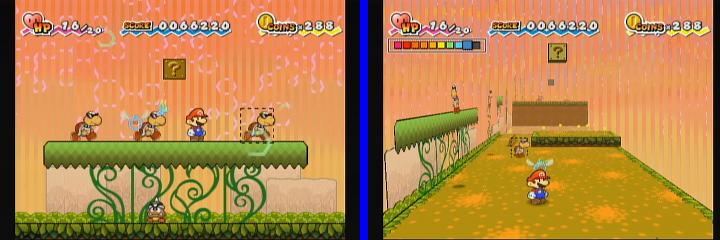
How the actual progress of the game meshes together with these two distinct elements is by going along in pieces of sorts. The platformer stages are broken down into "chapters," which each have multiple parts to it, similar in style to, say, something like "World 5-3 in Super Mario Bros. 1" or that sort of thing. So, these areas will be gone through in a fairly linear style. In between each of the parts bits of story will be given to move things along. At the end of the chapter it will come to a conclusion (including getting a particular item at the end of each chapter which is the driving reason for doing this to begin with), and in between the chapters the game goes back into a more RPG-like setting. Here, Mario can go back through the town, talk to people, take care of things that need to be done there, and find out how to progress to the next chapter. While if one was hoping to just be playing this in a strictly Platformer style these parts would seem to get in the way of that desire, if one is interested in both aspects, these serve as nice complements to each other, giving a bit of time to wander around and explore and such like that, taking a break from all the jumping on enemies.
The main stages, however, aren't just running and jumping along either. While the earlier chapters start out fairly straightforward and plain platforming, the later stages, while still built around that core, branch and expand out into many other things as well. For instance, along with the normal "running along and going across platforms" sorts of stages, and various other pieces familiar to platformers such as underwater stages as well, Mario will also find himself exploring an old mansion, flying through space, and all sorts of different situations. These different areas will at times take on aspects familiar to other games, such as an exploration adventure, or a space shooter even. So, there is definitely a variety to the different levels to keep things interesting and mix things up. Although if one is hoping to just be able to run and jump along, some of these later stages could get a bit frustrating as one finds themselves having to solve some puzzles and such to progress. While nothing's too complex or involved, and everything's usually pretty good about saying what needs to be done next and such like that, it does, again, involve a bit more than just running and jumping.
Along the journey, although it just starts out with Mario, and soon after the earlier-mentioned character who allows you to focus on the screen and get information about things, you'll come across a number of other characters of various sorts who will aid you in your journey as well. In addition to the character, called a "Pixl," that you start off with at the beginning, you'll come across other ones along the way, who will have other more specific abilities which will be necessary in order to progress through certain areas. So, as the game moves along, things do become a bit more RPG-puzzle oriented as far as that goes. It works things into this slowly, where it isn't overwhelming with too much stuff to do at the beginning, but as things progress through the game, there will be more challenges to work at aside from just jumping across platforms. In addition to the Pixls, without giving too much about later in the game away, Mario won't be the only specific character being controlled, and having a new character will give way to new abilities specific to that character. Each of these other characters you'll encounter along the way has their own particular abilities and strengths, and not only will it be useful to switch to another character depending on the situation, but also at times it will be needed to make it through different obstacles and such along the way. At any given time only one character and one Pixl are active at a time, but, switching between them all is just a matter of accessing them from a menu.
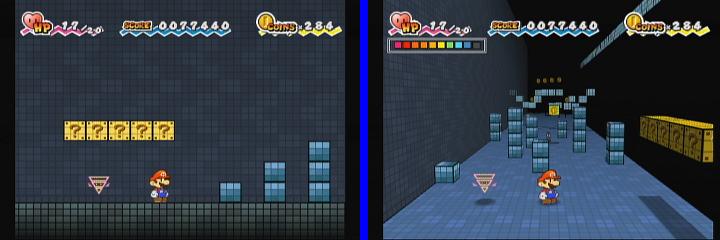
As far as the abilities go, and specifically Mario's ability, one of the major aspects of this game which really sets it apart in the platforming aspect, is the ability to "switch dimensions." When running along in a normal platforming mode, left to right or right to left as would be expected from that sort of thing, pressing the A button will flip everything to its side, presenting the same exact world one was passing through but from a 3D perspective. This particular feature really opens up a new and wonderful aspect of gameplay. "What if everything that you see, is more than what you see? The person next to you is a warrior and the space that appears empty is a door to another world? What if something appears that shouldn't? You either dismiss it or accept that there is more to the world that you think. Perhaps it is really a doorway, and if you choose to go inside, you'll find many unexpected things." - Shigeru Miyamoto. This particular quote, said well in advance of this game, seems like a perfect description of just what is going on here. Say, for instance, one is running along and encounters a wall which one can't pass. Simply flip the dimension, and find it's no more than a few blocks wide, allowing one to easily walk around it. Stuck in a room with no exit in sight? Flipping may reveal a passageway leading off to the side, around a corner, and off to another room. Or, of course, it may reveal a door just out of sight which is now plain to see.
More than just being a way to hide passages and get around walls, however, this feature works itself right in with the platforming gameplay. Have a huge enemy barreling down at you with nowhere to go? After flipping things, the enemy is nothing more than paper thin, and can be avoided by just taking two steps off to the side and letting it pass by. Want to see what's up ahead without spending all the time running over there to check? Flipping things allows one to see straight ahead, taking a look over all the upcoming enemies, obstacles and rewards on the path. At just the press of a button, having this completely new view on something as basic as a 2D platformer has some pretty amazing results. This is a perfect example of how the power and ability of a new system can give something which many may think of as "old" something completely "new" to it, opening up a whole new aspect of play. It's something like this that really makes the game stand out as something different, something new, something unexpected but something very enjoyable.
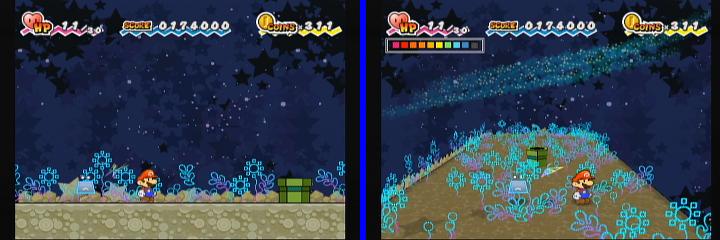
With the main gameplay parts being mostly in a straightforward platforming style, despite the RPG elements scattered throughout the game, as far as depth and reason to replay for typical RPG reasons go one won't really feel that sort of a pull back to this game. There are many different things to do, and hidden items to discover and such, but, it's not like there's a party of members and sidequests and all those other sort of stuff in a plain RPG. Still, compared to a platformer sort of game, there's definitely much more depth here. Although there aren't secret exits and different branches of levels like in Super Mario World or something, as far as just going through the levels go, they're all extremely involved and detailed, and all contain many different things to do. Although it's not necessary to explore everywhere and find everything in order to go through a level, especially in the more straightforward ones, there's much to do on the first time through, and when going back through again another time one can spend more effort trying to uncover the little hidden things throughout the course of the level. As well, although the RPG elements aren't too detailed, it's not like there's a need to "spend time leveling up" or anything like that, having that extra aspect there does make things more interesting, as opposed to just trying for a high score for the purpose of a high score. Also, in the town area that is outside of the level, although usually it's just a matter of going through it to find what needs to be done in order to go to the next level, if one does want to spend the time exploring it, there are a number of things to do and see there as well. So, aside from just wanting to go back through the game because of how fun it is, there will be a number of things that one may choose to go back through to do or accomplish as well.
There are a number of very different, and very noteworthy, things in this game just on its own, but, the important thing is how everything comes together to make up the game as a whole. The "paper" design, the different gameplay styles, the new abilities and options opened up by them, and everything else about the game all work together to make for a spectacular adventure. The graphics, although not the sort of "stunning 3D polygon" stuff that one may be used to recently, is excellently done. While doing something in a "paper" style may seem like an excuse to avoid having to work on that, as was the case in the previous Paper Mario games and is the case here as well, it's not just a style, and not just how it works into the gameplay itself, but, everything is beautifully crafted and put into the game. Even within the paper aspect, there are a number of different styles, such as a particular chapter all done with a purposely "large pixilated" look, which it pulls off to create a wonderful effect for the level in general. Everything about the game just does a spectacular job of working together to create one whole large unique feel for the game, with many styles similar to things one may be used to, but creating an overall effect like nothing one has ever experienced before.
